How to Install LAMP Stack on Ubuntu 24.04 Server/Desktop
This tutorial is going to show you how to install LAMP stack on Ubuntu 24.04 LTS. A software stack is a set of software tools bundled together. LAMP stands for Linux, Apache, MariaDB/MySQL, and PHP, all of which are open source and free to use.
It is the most common software stack that powers dynamic websites and web applications.
- Linux is the operating system.
- Apache is the web server.
- MariaDB/MySQL is the database server.
- PHP is the server-side scripting language responsible for generating dynamic web pages.
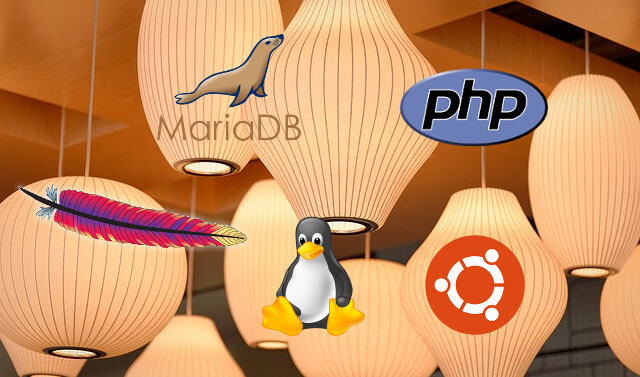
Requirements
To follow this tutorial, you need an Ubuntu 24.04 OS running on your local computer or on a remote server.
If you are looking for a virtual private server (VPS), I recommend Kamatera VPS, which features:
- 30 days free trial.
- Starts at $4/month (1GB RAM)
- High-performance KVM-based VPS
- 9 data centers around the world, including the United States, Canada, UK, Germany, The Netherlands, Hong Kong, and Isreal.
Follow the tutorial linked below to create your Linux VPS server at Kamatera.
Once you have a VPS running Ubuntu 24.04, follow the instructions below.
And if you need to set up LAMP stack with a domain name, I recommend buying domain names from NameCheap because the price is low and they give whois privacy protection free for life.
Step 1: Update Software Packages
Before we install the LAMP stack, it’s a good idea to update the repository and software packages. Run the following commands on your Ubuntu 24.04 OS.
sudo apt update sudo apt upgrade
Step 2: Install Apache Web Server
Enter the following command to install Apache Web server. The apache2-utils package will install some useful utilities like Apache HTTP server benchmarking tool (ab).
sudo apt install -y apache2 apache2-utils
After it’s installed, Apache should be automatically started. Check its status with systemctl.
systemctl status apache2
Sample output:
● apache2.service - The Apache HTTP Server Loaded: loaded (/lib/systemd/system/apache2.service; enabled; vendor preset: enabled) Active: active (running) since Sat 2024-05-11 11:31:31 CST; 2s ago Docs: https://httpd.apache.org/docs/2.4/ Process: 53003 ExecStart=/usr/sbin/apachectl start (code=exited, status=0/SUCCESS) Main PID: 53011 (apache2) Tasks: 55 (limit: 19072) Memory: 6.4M CGroup: /system.slice/apache2.service ├─53011 /usr/sbin/apache2 -k start ├─53012 /usr/sbin/apache2 -k start └─53013 /usr/sbin/apache2 -k start
Hint: If the above command doesn’t quit immediately, you can press Q key to gain back control of the terminal.
If it’s not running, use systemctl to start it.
sudo systemctl start apache2
It’s also a good idea to enable Apache to automatically start at system boot time.
sudo systemctl enable apache2
Check Apache version:
apache2 -v
Output:
Server version: Apache/2.4.58 (Ubuntu) Server built: 2024-04-18T15:13:41
Now type in the public IP address of your Ubuntu 24.04 server in the browser address bar. You should see the “It works!” Web page, which means Apache Web server is running properly. If you are installing LAMP on your local Ubuntu 24.04 computer, then type 127.0.0.1 or localhost in the browser address bar.
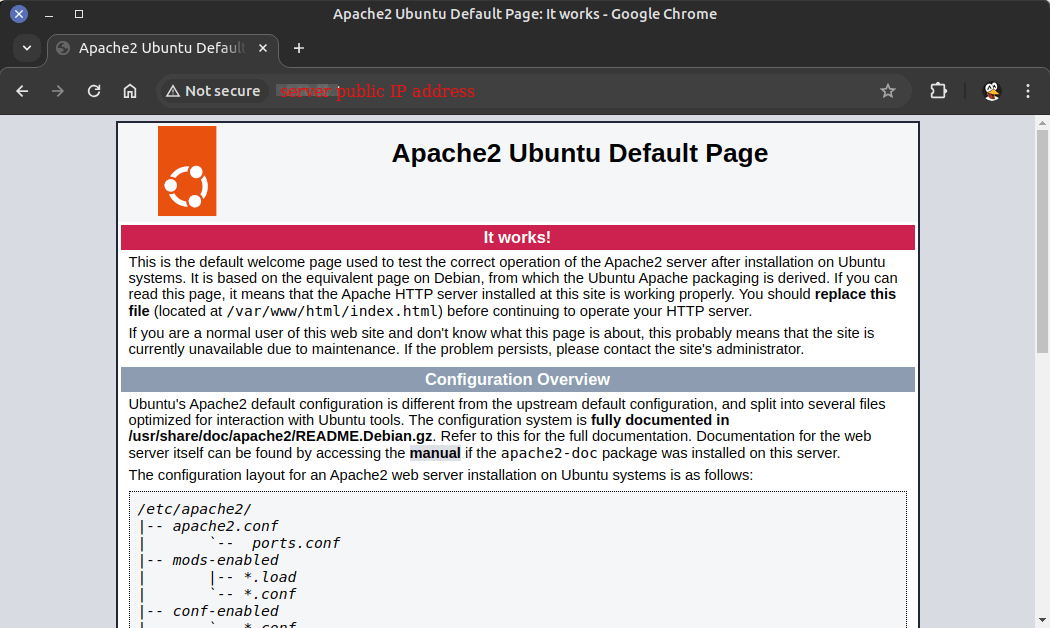
If the connection is refused or failed to complete, there might be a firewall preventing incoming requests to TCP port 80. If you are using iptables firewall, then you need to run the following command to open TCP port 80.
sudo iptables -I INPUT -p tcp --dport 80 -j ACCEPT
If you are using the UFW firewall, then run this command to open TCP port 80.
sudo ufw allow http
Now we need to set www-data (Apache user) as the owner of document root (otherwise known as web root). By default it’s owned by the root user.
sudo chown www-data:www-data /var/www/html/ -R
By default, Apache uses the system hostname as its global ServerName. If the system hostname can’t be resolved in DNS, then you will probably see the following error after running sudo apache2ctl -t command.
AH00558: apache2: Could not reliably determine the server's fully qualified domain name, using 127.0.0.1. Set the 'ServerName' directive globally to suppress this message
To solve this problem, we can set a global ServerName in Apache. Use the Nano command-line text editor to create a new configuration file.
sudo nano /etc/apache2/conf-available/servername.conf
Add the following line in this file.
ServerName localhost
Save and close the file. To save a file in Nano text editor, press Ctrl+O, then press Enter to confirm. To exit, press Ctrl+X. Then enable this config file.
sudo a2enconf servername.conf
Reload Apache for the change to take effect.
sudo systemctl reload apache2
Now if you run the sudo apache2ctl -t command again, you won’t see the above error message.
Step 3: Install MariaDB Database Server
MariaDB is a drop-in replacement for MySQL. It is developed by former members of MySQL team who are concerned that Oracle might turn MySQL into a closed-source product. Enter the following command to install MariaDB on Ubuntu 24.04.
sudo apt install mariadb-server mariadb-client
After it’s installed, MariaDB server should be automatically started. Use systemctl to check its status.
systemctl status mariadb
Output:
● mariadb.service - MariaDB 10.11.7 database server Loaded: loaded (/lib/systemd/system/mariadb.service; enabled; vendor preset: enabled) Active: active (running) since Fri 2024-05-10 14:19:16 UTC; 18s ago Docs: man:mysqld(8) https://mariadb.com/kb/en/library/systemd/ Main PID: 9161 (mysqld) Status: "Taking your SQL requests now..." Tasks: 31 (limit: 9451) Memory: 64.7M CGroup: /system.slice/mariadb.service └─9161 /usr/sbin/mysqld
Hint: If the above command doesn’t immediately quit after running. You need to press “q” to make it quit.
If it’s not running, start it with this command:
sudo systemctl start mariadb
To enable MariaDB to automatically start at boot time, run
sudo systemctl enable mariadb
Now run the post-installation security script.
sudo mysql_secure_installation
- When it asks you to enter MariaDB root password, press
Enterkey as the root password isn’t set yet. - Don’t switch to unix_socket authentication because MariaDB is already using unix_socket authentication.
- Don’t change the root password, because you don’t need to set root password when using unix_socket authentication.
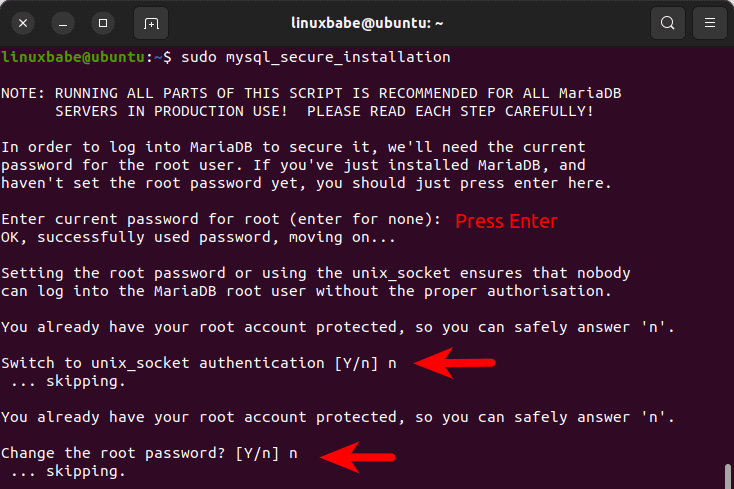
Next, you can press Enter to answer all remaining questions, which will remove anonymous user, disable remote root login and remove test database. This step is a basic requirement for MariaDB database security. (Notice that Y is capitalized, which means it is the default answer. )
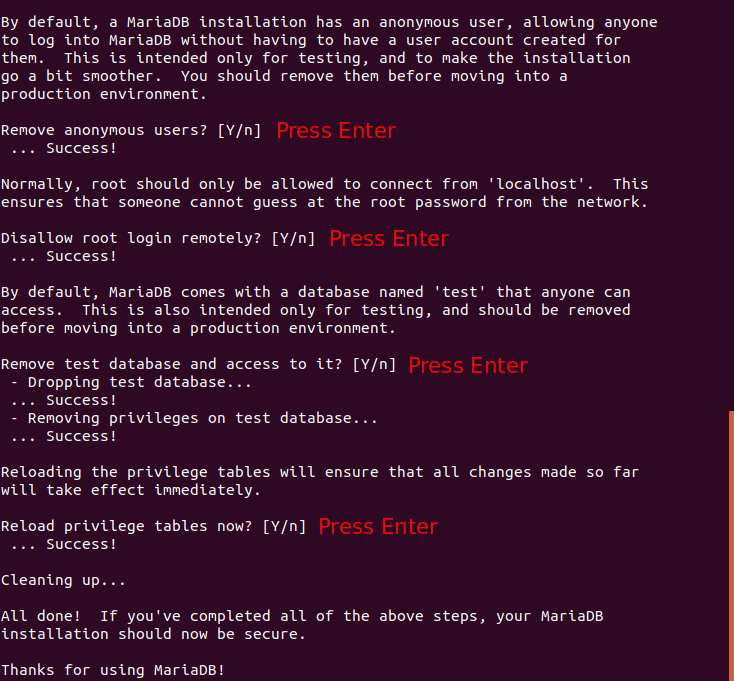
By default, the MaraiDB package on Ubuntu uses unix_socket to authenticate user login, which basically means you can use username and password of the OS to log into MariaDB console. So you can run the following command to log in without providing MariaDB root password.
sudo mariadb -u root
To exit, run
exit;
Check MariaDB server version information.
mariadb --version
As you can see, we have installed MariaDB 10.11.7.
mariadb Ver 15.1 Distrib 10.11.7-MariaDB, for debian-linux-gnu (x86_64) using EditLine wrapper
Step 4: Install PHP8.3
At the time of this writing, PHP8.3 is the latest stable version of PHP and has a minor performance edge over PHP8.2. Enter the following command to install PHP8.3 and some common PHP modules.
sudo apt install php8.3 libapache2-mod-php8.3 php8.3-mysql php-common php8.3-cli php8.3-common php8.3-opcache php8.3-readline php8.3-mbstring php8.3-xml php8.3-gd php8.3-curl
Enable the Apache php8.3 module then restart Apache Web server.
sudo a2enmod php8.3 sudo systemctl restart apache2
Check PHP version information.
php --version
Output:
PHP 8.3.6 (cli) (built: Apr 15 2024 19:21:47) (NTS)
Copyright (c) The PHP Group
Zend Engine v4.3.6, Copyright (c) Zend Technologies
with Zend OPcache v8.3.6, Copyright (c), by Zend Technologies
To test PHP scripts with Apache server, we need to create a info.php file in the document root directory.
sudo nano /var/www/html/info.php
Paste the following PHP code into the file.
<?php phpinfo(); ?>
To save a file in Nano text editor, press Ctrl+O, then press Enter to confirm. To exit, press Ctrl+X. Now in the browser address bar, enter server-ip-address/info.php. Replace server-ip-address with your actual IP. If you follow this tutorial on your local computer, then type 127.0.0.1/info.php or localhost/info.php.
You should see your server’s PHP information. This means PHP scripts can run properly with Apache web server.
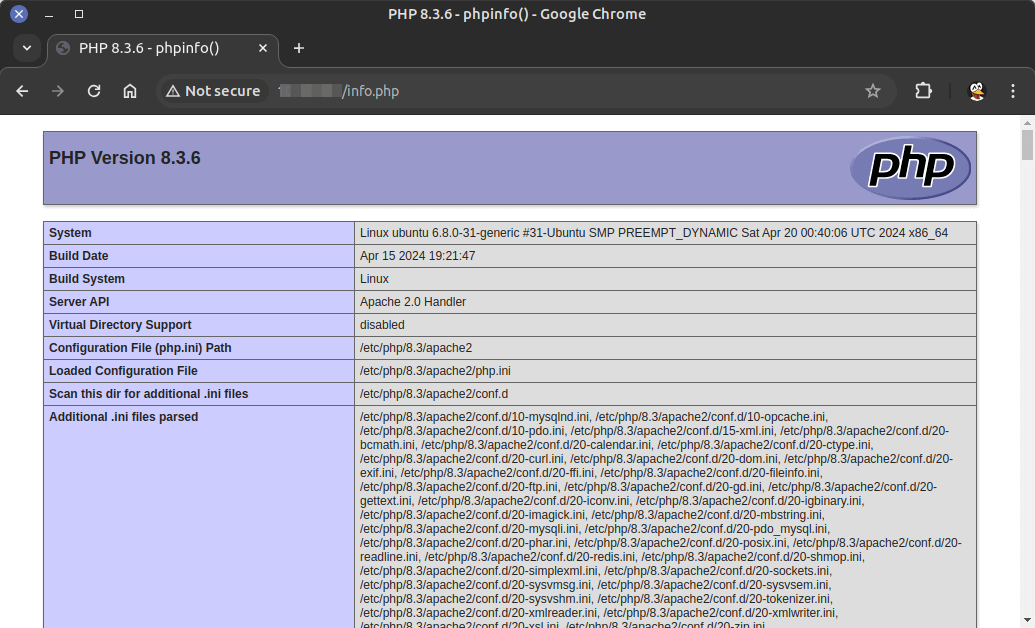
How to Run PHP-FPM with Apache
There are basically two ways to run PHP code with Apache web server:
- Apache PHP module
- PHP-FPM.
In the above steps, the Apache PHP8.3 module is used to handle PHP code, which is usually fine. But in some cases, you need to run PHP code with PHP-FPM instead. Here’s how.
Disable the Apache PHP8.3 module.
sudo a2dismod php8.3
Install PHP-FPM.
sudo apt install php8.3-fpm
Enable proxy_fcgi and setenvif module.
sudo a2enmod proxy_fcgi setenvif
Enable the /etc/apache2/conf-available/php8.1-fpm.conf configuration file.
sudo a2enconf php8.3-fpm
Restart Apache for the changes to take effect.
sudo systemctl restart apache2
Now if you refresh the info.php page in your browser, you will find that the Server API is changed from Apache 2.0 Handler to FPM/FastCGI, which means Apache web server will pass PHP requests to PHP-FPM.
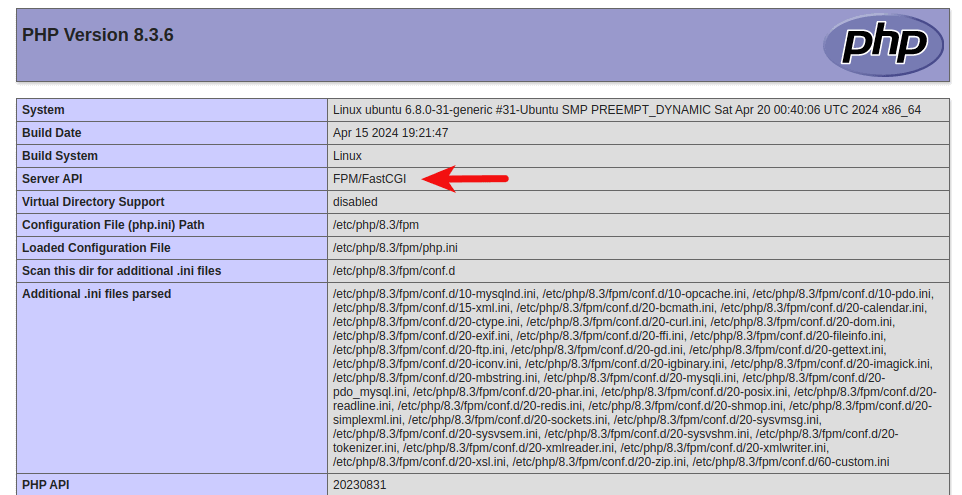
Congrats! You have successfully installed LAMP stack (Apache, MariaDB and PHP8.3) on Ubuntu 24.04. For your server’s security, you should delete info.php file now to prevent prying eyes.
sudo rm /var/www/html/info.php
Next Steps
I hope this tutorial helped you install LAMP stack on Ubuntu 24.04 LTS. As always, if you found this post useful, then subscribe to our free newsletter to get more tips and tricks.
Backup is important in case of hacking, data center disasters, etc. You should have a backup strategy for your server.
- Back Up and Restore MariaDB Databases From the Command line
- Use Duplicati to Back Up Files on Debian, Ubuntu, Linux Mint
Linux Server Performance Tuning and Monitoring
- Easily Boost Ubuntu Network Performance by Enabling TCP BBR
- How to Enable HTTP/2 Protocol with Apache
- Linux Server Performance Monitoring with Netdata (2022)
Take care 🙂



Amazing, thank you!
This is the only help I found that got PHP actually working. Thanks very much for the great work!!
Hi,
Thank you very much the material, very helpful. One last thing I am stuck on, the joomla http://localhost/joomla/installation/index.php is displaying “Error”. I don’t know where I have gone wrong, if you can kindly help I will be grateful.
You can check the Apache error log to see what went wrong.
Straight to the point and worked perfectly! Thank you.
Installed on Ubuntu 24.04 LTS
Thanks for this awesome tutorial! Installed the LAMP stack within 15 minutes on Ubuntu 24.04.
I’m stuck on the correct file permissions though. If I download my projects to the /var/www/html/ folder using sudo, I can set them to www-data user. But then I can’t open the folder using for instance Visual Studio Code, because my user doesn’t have permission to the www-data files and folders.
Any clue how to set them properly without having to change the files and folders permissions to 777?
Bit late, but you’d have to create a group and put both your user and the www-data user in the group, then give permissions to the group, chown -r www-data:your-group-name and then set the permissions to 776 or 771, depending on what you want guest to be able to do.
very helpful!
Could i use the same methods above for installation in linux lite 4.4 (based on ubuntu 18.04, debian) too ?
If your distro is based on Ubuntu 24.04, you can use the method in this article. If your distro is based on Debain 10, you can check out this tutorial: How to install LAMP stack on Debian 10 Buster
Yes. I could successfully install lamp in linuxlite 4.4. Thnx alot for the tutorial bro.
Thanks, man!
Comprehensive. Well written for clarity of understanding. Added extras to the installation. Install went perfect and obtained the intended results. Great job on this tutorial.
May I ask how to make sure we install latest packages? Thanks
Obrigado! Ajudou muito.
Just used this today, works great!
I am stuck, am using Ubuntu 22.04 LTS. Am getting enable to locate package php8.3 errors at Step 4: Install PHP8.3
anyone who knows what i am doing wrong?
thanks in advance
This guide works on Ubuntu 24.04.
Ubuntu 22.04 users should follow this guide: How to Install LAMP Stack on Ubuntu 22.04 Server/Desktop
many thanks for the redirection. Is there also a WordPress tutorial avaialble for LTS 20.04 or can i use this one:
You can follow this tutorial to install WordPress on Ubuntu 22.04 with LAMP.
You’re killing it! This was a 15 min install and config…Google Instance…Thanks so much!
Hello how are you?
Do you have a tutorial for deploying wordpress on LAMP server with Ubuntu Server 24.04?
Here it is: Install WordPress on Ubuntu 24.04 with Apache, MariaDB, PHP8.3 (LAMP)
Hey, thanks for the great guide.
I found a typo here, in the word MariaDB:
“By default, the MaraiDB package on Ubuntu uses unix_socket to authenticate user login,”